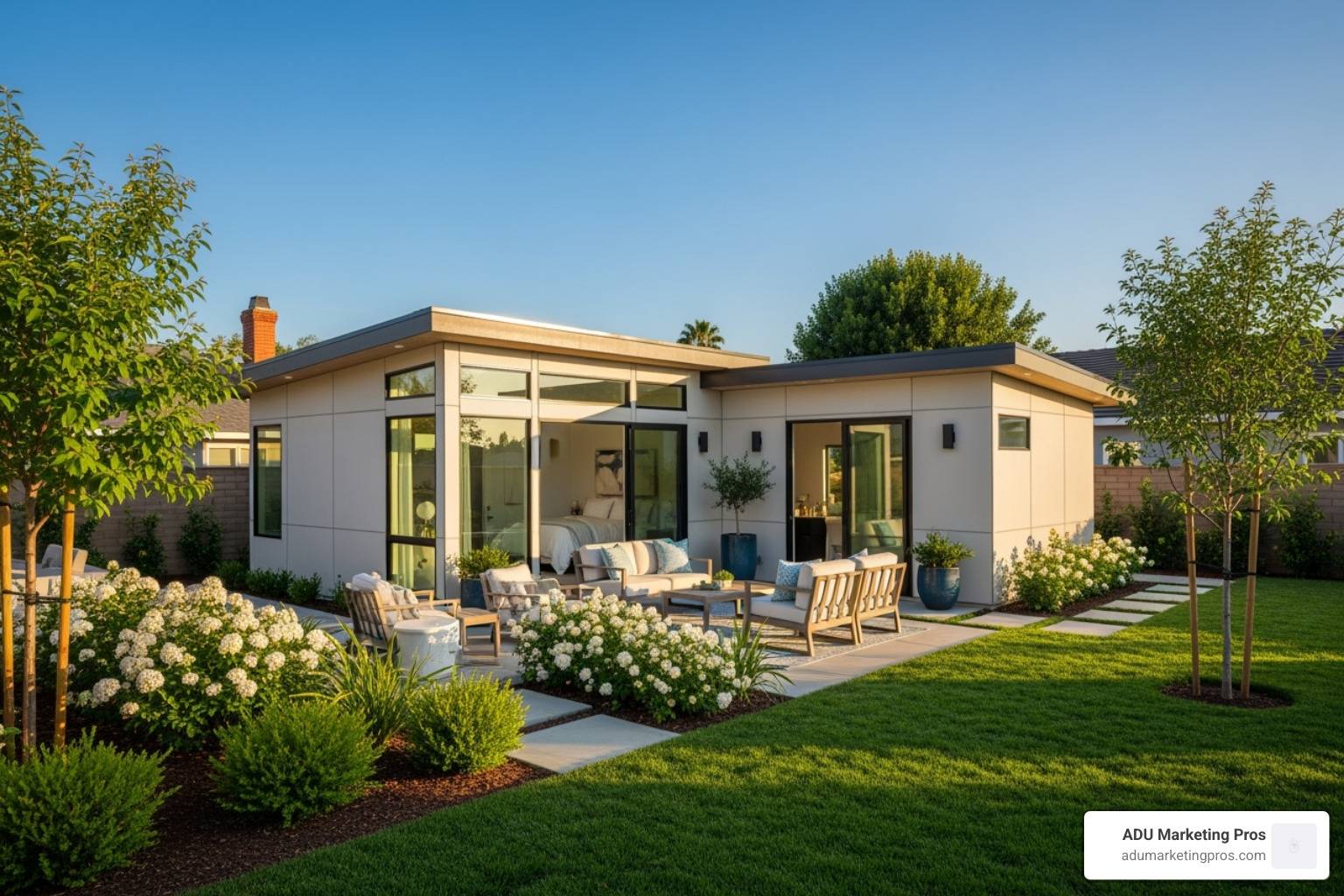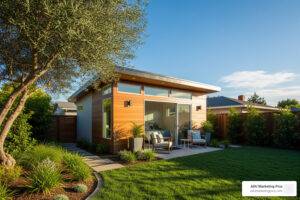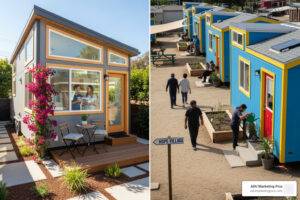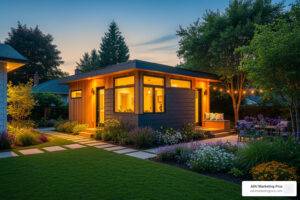The California Dream, Reimagined
What Qualifies as a “Small House”? Exploring Your Options
When you search small houses for sale in Southern California, “small” can mean anything from a 100 sq ft micro-cabin to a 1,200 sq ft backyard cottage. The real question isn’t the exact square footage—it’s which style matches your budget, lifestyle, and long-term goals.
Tiny Homes on Wheels (THOWs)
- Size: 100–400 sq ft
- Price range in SoCal: $55k–$160k
- Best for: Mobility, lower entry cost, off-grid capability
THOWs let you chase perfect weather (or work contracts) without giving up the comforts of home. Because they’re usually titled as RVs, you’ll owe minimal property tax and can finance through an RV loan. The trade-offs: finding legal parking, meeting RVIA standards, and living within strict space limits. See ADU vs. Tiny House: Understanding the Differences for a deeper comparison.
Foundation-Based Small Homes & Cottages
- Size: 400–800 sq ft
- Price range: $190k–$400k+ (land extra)
- Best for: Traditional financing, equity building, long-term stability
Built to the same codes as larger houses, these compact cottages qualify for conventional mortgages and appreciate like any other real estate. You lose the ability to relocate, but you gain standard utilities, easier insurance, and the peace of mind that comes with a permanent foundation. For design inspiration, check out Efficient Studio ADU Floor Plans.
Accessory Dwelling Units (ADUs)
- Size: 400–1,200 sq ft
- Build cost: $150k–$400k
- Best for: Rental income, multigenerational living, boosting property value
California’s ADU-friendly laws make it easier than ever to turn a backyard into a cash-flow machine. Many owners net $1,500–$3,500/mo in rent while adding 20–30 % to overall property value. ADUs also shine as home offices or private suites for aging parents. Find faster build options with Exploring Modular ADU Homes.
In short, decide whether mobility, permanence, or income potential matters most—then pick the small-house style that delivers.
The SoCal Small Living Scene: Popular Locations and Price Points
Southern California is a patchwork of micro-markets. A 500 sq ft cottage in Venice is a different animal from a 500 sq ft cabin in Joshua Tree. Below is a quick-hit guide to where the deals—and the vibes—differ most.
Los Angeles County: Urban Compact Living
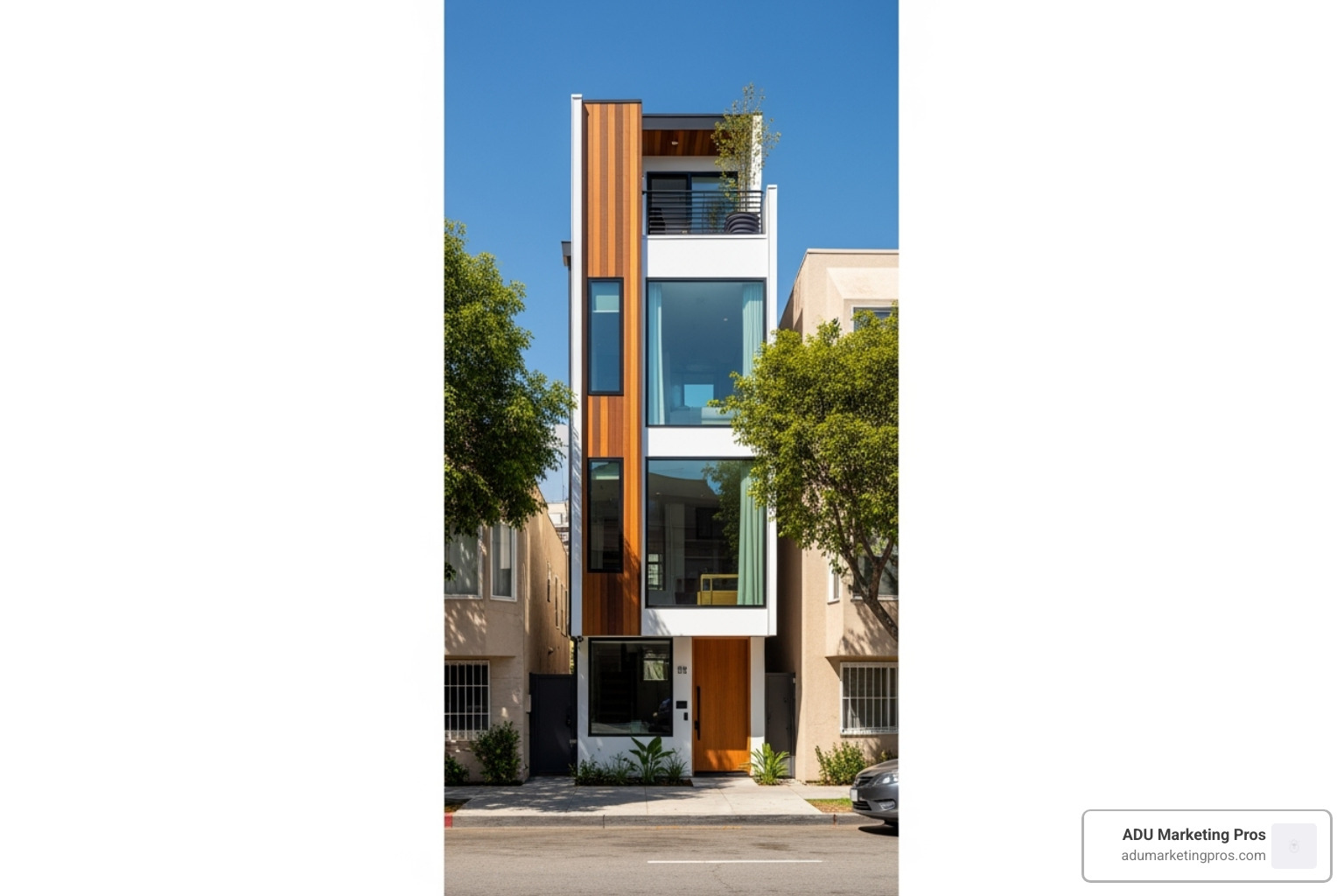
- West Side (Santa Monica, Venice): 500–800 sq ft homes list $600k–$1.2 M; ADUs generate $2.5k–$4k/mo rent.
- Valley (Burbank, Glendale): Smaller lots, friendlier prices—ADU builds $200k–$400k.
- Downtown & Central LA: Micro-lofts $400k–$700k; strong transit reduces car needs.
Outdoor culture and progressive ADU rules make LA a top pick if you can stomach the price tag. Browse Small House Listings in Los Angeles to gauge inventory.
San Diego County: Coastal Cottages & Backyard Units
- Coastal (Encinitas, Oceanside): 500–800 sq ft beach cottages $700k–$1.5 M.
- Inland (Escondido, Poway): 400–700 sq ft homes $400k–$800k on larger lots—ideal for ADUs.
- Climate bonus: decks and patios effectively double living space.
San Diego streamlines ADU permits and waives some impact fees, trimming months off build timelines. See current bargains via Redfin’s San Diego search.
Inland Empire & Desert Communities: Room to Breathe
- Riverside County: 400–800 sq ft homes $200k–$500k; abundant land for tiny-house communities.
- San Bernardino County (Joshua Tree, Twentynine Palms): thriving artist scene, off-grid potential; prices start $150k.
- High Desert (Victorville, Apple Valley): lowest entry point—plenty of one-acre parcels under $100k.
Cheaper land means more design freedom—from solar-powered THOW villages to sprawling ADU compounds. Connect with experienced builders through Finding Tiny House Builders in California.
Navigating the Market for Small Houses for Sale in SoCal
Buying (or building) a compact dwelling in Southern California involves more moving parts than just scrolling through listings. Below is a quick, actionable roadmap that seasoned buyers, first-timers, and even industry pros can follow to turn the idea of small houses for sale into a set of house keys in hand.
1. Get Crystal-Clear on Your Goal
- Lifestyle: Weekend surf shack, primary residence, or income-producing ADU?
- Mobility vs. Permanence: Decide upfront whether relocation flexibility is non-negotiable.
- Equity Horizon: Are you flipping in three years or planting roots for a decade?
Having a north-star objective lets you ignore shiny distractions and focus on properties that actually fit.
2. Line Up the Right Financing Early
- Sub-300 sq ft on wheels → Pre-qualify for an RV or chattel loan.
- 400–1,200 sq ft on foundation → Conventional, FHA, or VA mortgage (most lenders want ≥320 sq ft, so verify).
- Backyard ADU builds → HELOC, cash-out refi, or construction loan.
Pro tip: lenders still play catch-up with alternative housing. A broker who routinely closes tiny-home and ADU deals can shave weeks off underwriting.
3. Dial in Your Zoning & Permits
Before you make an offer, confirm:
- Minimum dwelling size and height limits.
- Off-street parking requirements (often waived for ADUs within ½-mile of transit).
- Hook-up fees for utilities.
Use the California Department of Housing & Community Development’s interactive maps (https://www.hcd.ca.gov) and check the city’s municipal code. A five-minute phone call to the planning desk can save a five-figure mistake later.
4. Build the Right Team
- Real-estate agent experienced with micro-properties.
- Architect/Designer fluent in space-saving layouts.
- ADU-friendly contractor who knows local inspectors on a first-name basis.
ADU Marketing Pros maintains a vetted network of these specialists across Los Angeles, San Diego, and Inland Empire markets—ask us for an intro.
5. Run the Numbers, Then Run Them Again
Factor in: land, base build, site work, permits, contingency (10–15 %), furnishings, and—if you plan to rent—management fees. For ADUs, our clients often cover the entire monthly loan payment with rent, but only after accurately modeling vacancy rates and maintenance.
6. Future-Proof Your Exit Strategy
Small homes appreciate differently by location and build type. A THOW depreciates like an RV, while a well-designed 600 sq ft cottage in Santa Monica can outperform larger tract homes on a per-square-foot basis. Plan your resale or refinance path on day one.
Bottom line: Southern California offers best variety, but success hinges on informed decisions. Follow this roadmap, leverage specialized pros, and the process of finding (or creating) the perfect small house becomes far less intimidating—and far more rewarding.
Frequently Asked Questions about Southern California Small Homes
How much does a tiny house cost in Southern California?
- THOWs: $55k–$160k turnkey.
- Foundation small homes: $150k–$400k (plus land).
- ADUs: $150k–$400k build cost, often recouped through rent.
Remember to add land, site prep, and permits (another $15k–$75k depending on location).
Are tiny homes and ADUs legal?
- ADUs: Protected statewide; most cities must approve compliant plans up to 1,200 sq ft.
- THOWs: Treated as RVs—legal in RV parks, some backyards, and designated communities; rules vary block to block.
- Foundation small homes: Must meet local minimum-size and building-code standards.
Find the latest rules at the CA Department of Housing & Community Development: https://hcd.ca.gov.
How can I finance a small house?
- Conventional mortgage: Works for code-compliant homes on permanent foundations.
- RV loan or chattel mortgage: Best for THOWs and manufactured units.
- HELOC / cash-out refi: Popular for funding backyard ADUs.
- Owner carry & rent-to-own: Growing options when banks say no.
Talking to lenders familiar with tiny homes saves time—many national banks still enforce old minimum-square-footage rules.
Conclusion: Making Your Big Move into a Small Home
The journey through Southern California’s small houses for sale market reveals something remarkable: the California dream isn’t disappearing—it’s evolving. What we’re witnessing isn’t just a housing trend, but a fundamental reimagining of what home means in the 21st century.
Think about it: while the average California home hits $703,446, small houses are opening doors that seemed permanently closed. That $55,000 tiny home suddenly makes homeownership possible for the teacher who thought she’d rent forever. The $300,000 ADU transforms a retiree’s backyard into a monthly income stream of $2,500. The $400,000 foundation-based small home gives a young family their first taste of equity building.
We’ve explored how Southern California’s diverse geography creates unique opportunities. Los Angeles County offers urban sophistication where compact living meets big city amenities. San Diego County provides that coveted coastal lifestyle with year-round outdoor spaces that effectively double your living area. The Inland Empire delivers affordability and room to breathe, where desert modernism meets practical living.
But here’s what makes this movement truly exciting: it’s not about compromise. The best small houses for sale aren’t scaled-down versions of traditional homes—they’re purpose-built for modern life. Multi-functional furniture that transforms throughout the day. Outdoor kitchens that extend entertaining space. Smart home technology that maximizes efficiency. These homes are designed for how we actually live, not how we lived fifty years ago.
The financing landscape continues to evolve too. Traditional mortgages for foundation-based homes, creative HELOC solutions for ADUs, and specialized RV loans for tiny homes on wheels. The market is responding to demand with innovative solutions that make small house ownership accessible to more people than ever before.
For builders and architects, this represents an incredible opportunity. The demand spans from mobile tiny homes to permanent ADUs, creating multiple specialization paths and revenue streams. The challenge isn’t finding customers—it’s connecting with the right ones who understand the value of quality construction and thoughtful design.
This is where ADU Marketing Pros makes the difference. We help construction and architecture firms cut through the noise and connect with qualified homeowners ready to accept small house living. Instead of competing on price alone, we help firms showcase their expertise and build relationships with clients who value craftsmanship and innovation.
The small house movement in Southern California represents something bigger than real estate—it’s about choosing intentionality over excess. It’s about financial freedom over mortgage payments that consume half your income. It’s about experiences over square footage, community over isolation, and sustainability over waste.
Whether you’re drawn to the mobility of a tiny home on wheels, the investment potential of an ADU, or the permanence of a foundation-based small home, Southern California’s market offers unprecedented variety and opportunity. The infrastructure is here, the financing is evolving, and the community is growing.
The future looks bright for small house living in Southern California. With streamlined permitting processes, innovative designs, and a growing acceptance of alternative housing models, we’re just at the beginning of this change. The California dream isn’t dead—it’s been rightsized for a new generation of homeowners who understand that sometimes the biggest move you can make is into something smaller.
Explore our portfolio of eco-friendly small homes and ADU designs to start your journey toward your own big move into small living.

